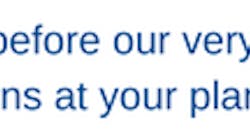Many people who attend leadership training are disappointed by the return on their investment in money and time. After the training. they get back to the plant and have difficulty getting traction. It’s as though they are surrounded by barriers to applying good leadership practices.
Productive leadership happens when good leadership practices actually deliver results. For this to occur, more is needed than just the exhibition of typical leadership skills such as time management, strong interpersonal communication, etc. There also has to be an environment that allows leadership skills to be effective.
As we discussed last month, W. Edwards Deming said in 1993, “A bad system will beat a good person every time.” We can define a system as a group of interdependent activities and resources intended to perform a function. A bad system would have undefined or poorly defined activities and/or insufficient resources.
Good people would include managers, supervisors, and workforce personnel who want to go to work every day and do a good job. That’s most people.
What distinguishes a bad system from a good system? A good system starts at the top. Executive or senior leaders need to provide the strategic direction across departments and functions. Departments are groups such as human resources, operations, maintenance, finance, contracting, engineering, and marketing. Functions are subdepartment-level groups or work centers where actions or activities within each department are carried out. Operations might have fabrication, assembly, and packaging functions, for example. A good system needs strategic direction to serve departments and functions. This includes:
This article is part of our monthly Human Capital column. Read more from Tom Moriarty.
- organizational objectives,
- policies for department/functional roles and responsibilities,
- department or function performance expectations,
- the resources required to meet objectives and performance expectations and carry out roles and responsibilities.
Organizational objectives answer the question, “What is it that the organization exists to do?” They provide the North Star for decision-makers at all levels. Decision-makers must be able to visualize and articulate how their decision contributes to the organizational objectives.
Departmental or functional roles and responsibilities must be clearly stated. This is for two very important reasons. First, doing so defines accountability for the various activities that need to be performed. When roles and responsibilities are explicitly stated, gaps and overlaps can be identified and resolved by senior leaders. In addition, mid-level and lower-level leaders can then be held accountable for their roles and responsibilities.
The second reason roles and responsibilities need to be clearly defined is that they provide a way to identify the resources required for each department or function. Senior leaders cannot expect lower-level leaders to perform to expected levels if they don’t provide sufficient resources. The resources provided indicate the level of performance that senior leaders expect. In many organizations, the accountable senior leaders state one desired performance level but provide resources to perform at a much level.
When organizational objectives, roles, responsibilities and performance expectations are clear and resources are sufficient, the onus for performance shifts to department and function leaders. These mid- and lower-level leaders are accountable for deploying resources efficiently and effectively. Efficient deployment of resources means only the minimum required resources will be used to carry out roles and responsibilities. Effective resource deployment means performance targets are met or exceeded indefinitely. A department/function-level management system must allow for:
- control and stability of day-to-day activities and
- proactive improvement of day-to-day activities.
Stated simply, senior leaders are accountable for defining responsibilities and providing sufficient resources. It’s on the department or function leaders to deploy available resources efficiently and effectively. The best leadership training in the world won’t move the needle if the organizational environment won’t support leadership practices.



